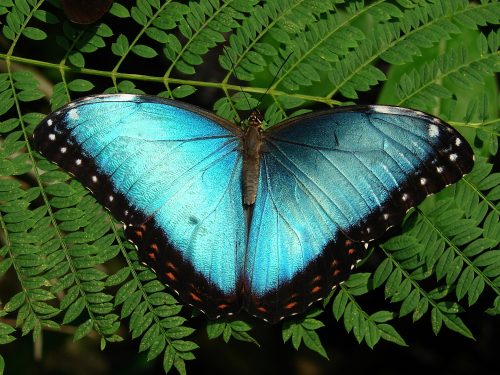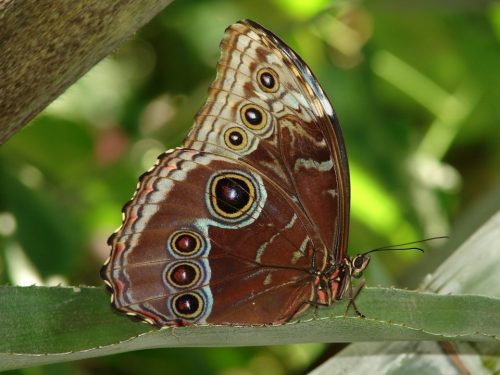
The ubiquitous Blue Morpho, Morpho helenor or Morpho peleides, as many butterfly houses list them, is easily the king of any butterfly garden that displays exotic butterflies. Few butterflies capture the beauty of nature and the imagination of people like the Blue Morpho, and it is nearly inconceivable to picture the Butterfly Rainforest exhibit without them. Because there is so much to say about the Blue Morpho, please forgive me if I only touch on a few aspects about this beautiful butterfly.
As many Lepidoptera enthusiasts know, the Blue Morpho is only blue on the top, or dorsal, side of its wings, and actually isn’t truly blue. What is seen when a Morpho opens its wings is refraction, meaning when light hits the wings, blue is the only color not absorbed by the wing scales, and it is reflected back for us to see. This is also why the shade of blue changes depending on the angle from which the wings are viewed.

Generally, Blue Morphos prefer the relative safety their more cryptic ventral, or underside, colors provide. In the Butterfly Rainforest, the best time to see and photograph a Blue Morpho with its wings open are sunny days with milder temperatures in the mid-60s or low 70s. On these days, the Blue Morpho will open and bask in the sun to warm itself before flying to feed. In the hotter months it is nearly impossible to enjoy the sight of a Blue Morpho resting with its wings open.
But those chances increase with higher populations, and during the next few months, Butterfly Rainforest visitors will be treated to far more Blue Morphos than normal. The exhibit typically displays about 50 Blue Morphos during a two-week period. But through May, that number jumps to 200! So if you have an affinity for these stunning butterflies, now is an excellent time to see them.
- For more information, please email rfessenden@flmnh.ufl.edu.